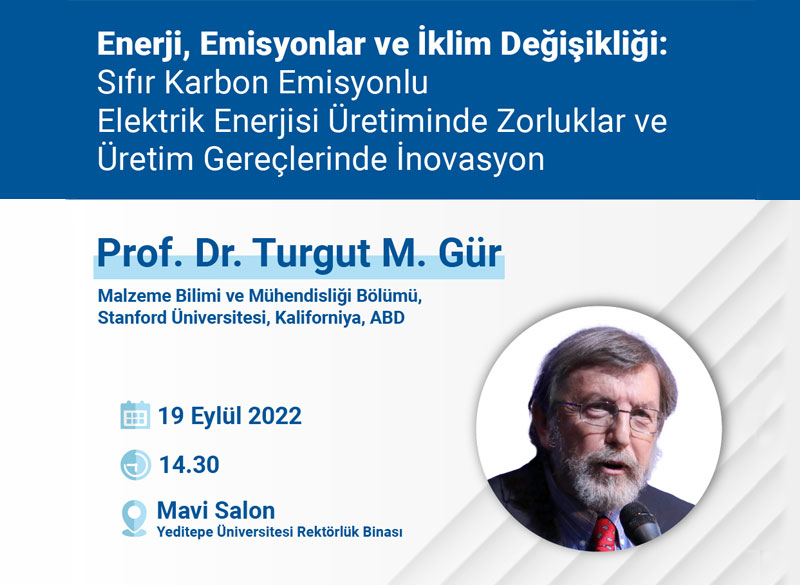Energy, Emissions, and Climate Change: Challenges in Zero Carbon Emission Electricity Generation and Innovations in Production Resources

Energy, Emissions, and Climate Change: Challenges in Zero Carbon Emission Electricity Generation and Innovations in Production Resources
Turgut M. Gür
Department of Materials Science and Engineering Stanford University
Stanford, California 94305, USA turgut.gur@stanford.edu
The transition to sustainable energy poses significant challenges, as energy policies can directly impact the environment, as well as food and water production, and can even trigger mass migrations. Our dependence on fossil fuels contributes to an annual emission of 37 billion tons of carbon dioxide, directly related to climate change and global warming. This poses a significant threat to our carbon-limited planet and the well-being of future generations.
The transformation of essential sectors of the global energy economy into clean and sustainable energy sources requires a multifaceted strategy and technological diversity to ensure energy security during the fight against climate change and global warming. Critical components of this strategy include:
Significant increases in renewable energy capacity.
The rapid development of scalable energy storage technologies.
The need for carbon emissions pricing through techniques such as the mixing of fossil fuels with air and the development of oxygen conversion technologies.
Carbon capture and storage technologies must also be implemented on a billion-ton scale. Developments in these areas depend on the characteristics and performance of production resources. Therefore, innovations in production resources are at the heart of collective efforts to reduce and capture carbon dioxide emissions while meeting our energy demands.
In my presentation, I will frame global energy and electricity conditions in the context of carbon dioxide emissions, emphasizing the magnitude of the challenges that await us globally. I will also start by examining some of the production resources and technologies in energy storage and carbon dioxide capture. My presentation will then focus on oxygen-based energy production, highlighting the conversion of high- temperature fuel cells to convert fossil fuels into electricity. If time permits, I will also provide examples of how nanofabrication tools can be effectively used to enhance the efficiency and performance of energy conversion and storage systems, including atomic-scale boundaries and the surface and interface engineering of functional oxides.
Biography:
Turgut M. Gür, a retired guest professor of the Department of Materials Science and Engineering at Stanford University, has a nearly forty-year, successful academic career, including chairmanships of three multidisciplinary and thematic research centers on advanced materials and energy conversion and storage. He was recently retired.
Gür was elected President of the Electrochemical Society (ECS), one of the oldest scientific societies in the United States and the most significant international society in its field, which hosted 16 Nobel laureates and
In the past, Gür served for more than ten years on the Board of Directors of the International Society for Solid State Ionics (ISSI) and for more than ten years as an associate editor of the Journal of the American Ceramic Society (JACerS). He also holds the title of Guest Professor from the China University of Mining and Technology – Beijing (CUMTB) and "International Mentor" from the Norwegian University of Science and Technology (NTNU) in Trondheim, Norway.
Gür is an internationally recognized leader in high-temperature electrochemical energy conversion and storage technologies, with 11 patents granted in the United States, 165 technical publications, 150 presentations at international conferences, and more than 80 invited lectures, courses, and colloquia. He is frequently cited in areas including converting clean coal to electricity, chemical-assisted hydrogen production, industrial wastewater remediation, and ruthenium oxide-based supercapacitors. He has also taken on technical leadership roles in several start-up companies.
Gür completed his undergraduate and master's degrees in the Department of Chemical Engineering at Middle East Technical University. He holds three graduate degrees, including a Ph.D. in Materials Science and Engineering from Stanford University.